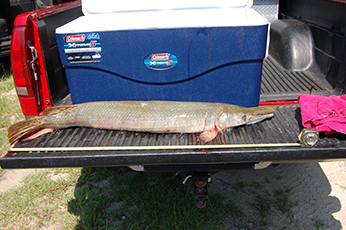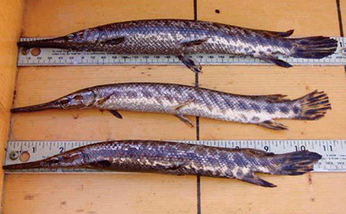(Family Lepisosteidae)
General Description
 Alligator gar (Atractosteus spatula). Photo courtesy of South Carolina Department of Natural Resources.
Alligator gar (Atractosteus spatula). Photo courtesy of South Carolina Department of Natural Resources.
 Spotted gars (Lepisosteus oculatus) confiscated by CDFW wardens. Photo by CDFW.
Spotted gars (Lepisosteus oculatus) confiscated by CDFW wardens. Photo by CDFW.
Gars are large, freshwater fish belonging to the Lepisosteidae family, which consists of 7 species of gar: alligator, Cuban, Florida, longnose, shortnose, spotted, and tropical. Gars have long, cylindrical bodies covered in hard, shiny, diamond-shaped scales. Their dorsal and anal fins sit far back on the body, near the tail. They have slender snouts with sharp, needle-like teeth. Gars are generally green to brown in color on their top and sides and white to yellow on their bellies; some species have spots on their bodies and/or fins. The different species of gar can be distinguished by snout length, number of rows of teeth, and the amount and location of spots. Depending on the species, adult gar range from 1 to over 9 feet long. The largest species of gar, the alligator gar, has been reported to grow up to 10 feet and weigh 350 lbs.
Current Distribution
Gars are not currently found in California. Alligator gars have been collected in California waters on a few occasions, but these fish were likely the result of aquarium releases. Five of the seven gar species are native to the United States. Gars are currently found within and outside of their native ranges in the United States from the Great Lakes basin in the north, south through the Mississippi River drainage to Texas, Mexico, and Florida. Florida gars are only found in Florida and Georgia. Cuban gars are native to Cuba and tropical gar are native to southern Mexico, and Central and South America.
Habitat Preference
Gars prefer warm, shallow, well-vegetated freshwater habitats in slow-moving rivers and lakes. Some gars also frequent brackish water. Gars have a primitive swim bladder that they can use as a lung to breathe air, which allows them to survive in waters with low levels of dissolved oxygen.
Pathways
Gars have some economic value in the aquarium trade and aquaculture industry (both for native stock restoration and as a food fish) however they generally have little commercial value in the United States. Gars are also a popular sport fish. Current pathways for the introduction of gars into new areas include escapement from aquaculture facilities, intentional release by fisherman, and, most commonly, release by pet owners. Gars are on California’s list of restricted animals and cannot be imported, transported, or possessed without a permit.
Impacts
Gars are top predators in the aquatic environment that lay and wait and ambush prey. Gars primarily eat fish, but will consume crabs and other crustaceans, waterfowl and other birds, small mammals, turtles, and carrion. Gars have few natural predators, such as alligators, large fish and birds, and cottonmouth snakes. Where introduced, gars may prey upon and out-compete native species and subsequently disrupt local ecosystems. If gars were to become established in California, they could threaten native fish populations such as salmon and trout. Additionally, although the flesh of gars is edible, their eggs are poisonous to humans, birds, and other mammals.
Actions Taken if Found
If this species is found in California, do not release it. Preserve (freeze) the specimen and immediately contact the CDFW Invasive Species Program, or email us at Invasives@wildlife.ca.gov, or (866) 440-9530. If found for sale, please report to 1-888-DFG-CALTIP (888-334-2258).